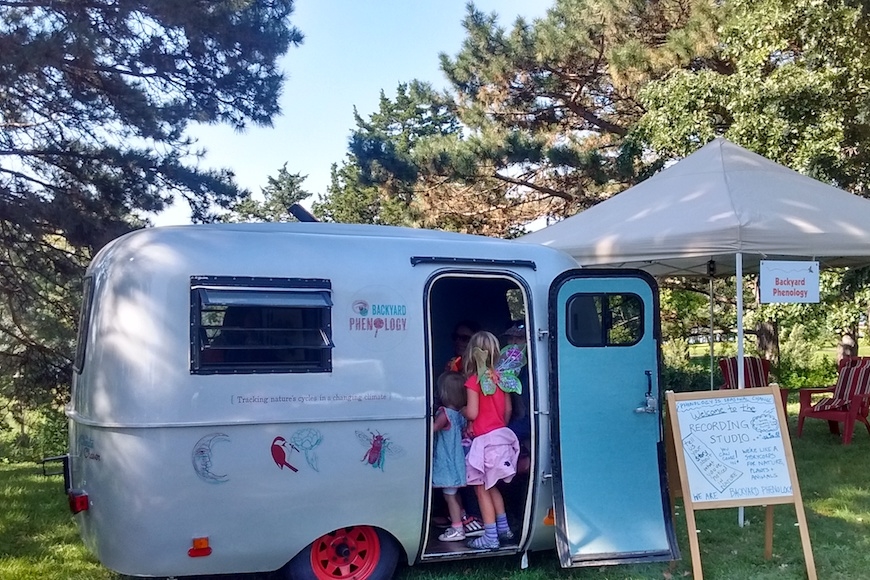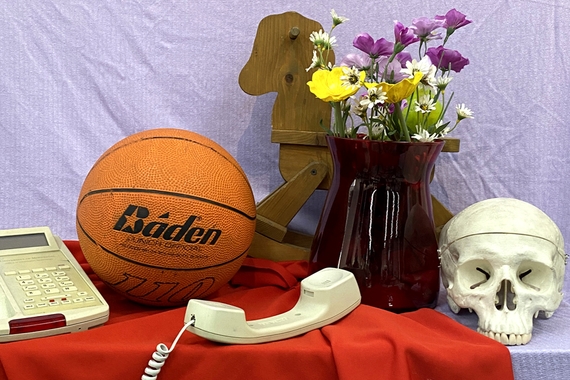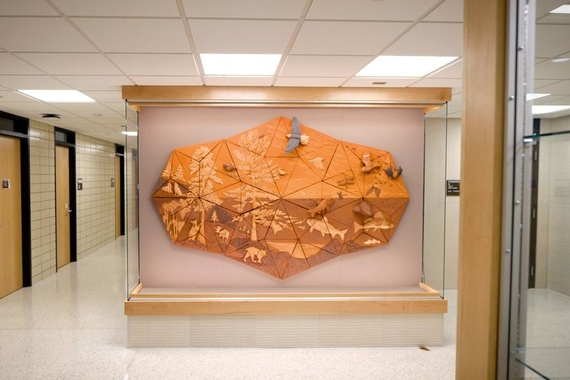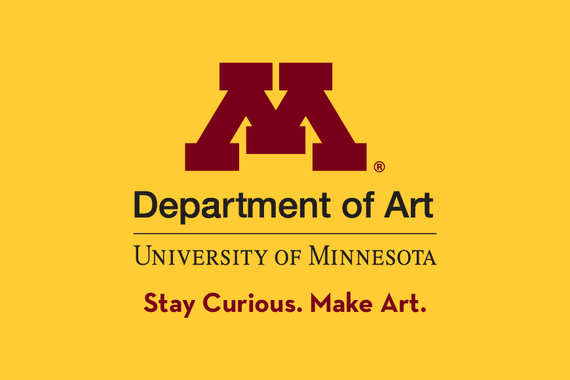Citizens of Change: Creating a Climate of Connections
“How do you think change happens in the world?”
It is a broad question, open to personal interpretation, and the most frequent question art professor Christine Baeumler finds herself asking. So far, she and her team have surveyed local people to gather over 600 responses that speak to all walks of life. Baeumler asks the question as a lead-in to her research project entitled The Backyard Phenology Project, an interdisciplinary collaboration that involves scientists, artists, researchers, undergraduate and graduate students, and community volunteers and aims to “connect communities to the natural world.”
Baeumler has sought to raise awareness about ecological issues through studio practice and by engaging communities in environmental projects. The Backyard Phenology Project was born out of a 2016 Grand Challenges class that Baeumler initiated with CFANS colleagues Rebecca Montgomery and Nicholas Jordan to learn about climate change and have the students create a collaborative public art piece for the Northern Spark’s “Climate Chaos/People Rising” all night art festival at the end of the course. “It really is about combining participatory art and citizen science,” Baeumler reflects. “It’s about creating a listening platform for others to contribute.” The various approaches and directions that the project has taken since its conception stem from Baeumler always asking herself questions like “What can we do as a team?” and “What can I do as an artist?” to push past typical art installations and create a much more interactive experience for people of all ages.
Breaking the Ice
The project’s name is one of the first things that Baeumler often tackles with newcomers. “I feel like it’s an icebreaker,” she says of the word phenology, which refers to the study of seasonal and cyclical changes in nature. It is not to be confused with the word phrenology, an outdated mythology that drew conclusions about a person’s mental capabilities and personality based on the shape of their skull—definitely not what Baeumler is studying.
“It’s a complicated word to explain easily recognizable processes,” she laughs. A lot of participants aren’t sure they know what the word means when they show up to project events, but Baeumler assures them that they already understand more about phenology than they think they do. For instance, being aware of things like the changing colors of autumn leaves and the amount of rainfall from last night’s thunderstorm reveals that you are already an unconscious observer of nature’s cycles and seasons. That initial conversation about what phenology means is actually one of Baeumler’s favorite parts of the project. “I love to see the light bulbs go off,” she says. “The word has been a great tool.”
The project kicked off after Baeumler received a 2016 Grand Challenges grant. In addition to the student project for the all night art festival that is held every year in June, co-instructor Rebecca Montgomery and graduate teaching assistant Kate Flick were invited by Northern Spark director Steve Dietz to do a faculty project. Thus, the Climate Chaser was born: a 1970’s camper that Baeumler remodeled into a sound studio in order to gather people’s stories of climate change. This “camper of curiosity,” as Baeumler calls it, includes specimens of a young robin, some small mammals, and an opossum skin, as well as a few resin-encased insects on permanent loan from the University’s Bell Museum of Natural History. She and her team of professors and volunteers travel around the metro area, collecting and recording nearly a thousand sources of “informal data” through interviews. She and her team modeled the format on the National Public Radio’s StoryCorps program. The team is currently working to categorize the interviews by theme before they post them as podcasts on the Backyard Phenology project’s website.
A Second Branch
Baeumler and professors Rebecca Montgomery, Nicholas Jordan, and Mae Davenport—whose focuses include forest ecology, forest resources, and social sciences, respectively—made up the early team of researchers. They were joined by Beth Mercer-Taylor, the Sustainability Coordinator at the Institute on Environment and Cante Suta/Francis Bettelyoun, the coordinator of the Native American Medicine Gardens. The team received a Grand Challenges Research Grant in 2016 for their work in Backyard Phenology Project, which allowed them to hire an outreach coordinator, Sam Graf, and to initiate more involvement with both graduate and undergraduate students. The project currently has enlisted two Undergraduate Research Partnership (UROP) students Jonnelle Walker and Rachel Nichols, as well as graduate students Jessica Lackey and Sarah Nichols.
The Backyard Phenology Project has been hosted on the University of Minnesota Saint Paul campus by the Native American Medicine Gardens in St. Paul and its Landscape Designer, Cante Suta/Francis Bettelyoun. Under his direction, a second branch of the project began to emerge. From February to November, the Medicine Garden hosts workshops related to phenology and indigenous knowledge. These workshops feature presenters such as entomologists, astronomers, and indigenous speakers. Francis Bettelyoun also holds talking circles that give participants a chance to reflect and listen to others’ stories, and Baeumler says that those who do come often return to more events
Rebecca Montgomery has set up particular plants in which participants are encouraged to search out tangible changes in the the life cycle of the species. They can then upload their observations and findings as relevant scientific data to the Minnesota Phenology Network. “One of the reasons we study is to aggregate data for patterns on seasonal change,” Baeumler says. The data that is collected is used in wider research projects conducted by the Minnesota Phenology Network and their partners, who post their organized data sets on the Minnesota Phenology Network website.
Sustainable Success
Because of their successful partnership with the Native American Medicine Gardens, the team was inspired to reach out and establish a second host site at Silverwood Park in St. Anthony Village. Baeumler’s vision is for Silverwood Park to become a nature and art venue, where participants and programmers of the project work together to co-create a phenology trail.
The Backyard Phenology team has held two co-design workshops at Silverwood and consulted a naturalist to find the most interesting and impactful places to further observe the landscape and the wildlife there. They have also begun holding Backyard Phenology workshops there, on topics such as animal track identification, our relationship with Mother Earth, and how to record phenological data. The participants’ input on what they would like to observe on phenology trails will help the team to do more than just “create installations.” Instead, Baeumler and the team are exploring ways to create “sustainable and gentle interventions in the landscape” that serve as observation stations by enhancing the area without altering it. Baeumler envisions it as “a prompt for people to observe” and continue contributing to the project rather than simply artwork for them to admire.
One in Many
What started as a one-time University class in 2016 has become a full-fledged research project in a mere two years with two host sites and a lab on wheels. Baeumler maintains that the collecting and sharing of scientific data is increasingly important. She also cites the Climate Chaser interviews and stories as a form of social practice.
“You are an expert in your own backyard,” she points out. “And you can be any age to do this.” Considering the opportunities the project presents and the breadth of people it engages, Baeumler says that what she has found most poignant about the project is the relationships and trust it has built between its many moving programs and participants. As she concludes, “You set out to do one thing and other parts emerge.”
With good weather on the rise, the Climate Chaser is once again making its rounds, and the Native American Medicine Gardens have begun hosting workshops. The Backyard Phenology project is open to any and all, and those who are interested in participating are encouraged to reach out or attend one of their events, which are posted online on the Backyard Phenology calendar.
This story was written by an undergraduate student account executive in CLAgency. Meet the team.



